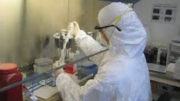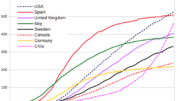Justin Kipness is a senior planning to study biology at Brown University in the fall. Each week, he will trace the coronavirus pandemic from its origin in Wuhan, China all the way to Stamford, CT.
A virus leapt to market-goers in Wuhan, China, 7,500 miles away, and panic stirred among students walking through the halls of Westhill High School. Change that – students are no longer walking through the halls, as school has been temporarily shut down. This novel coronavirus has unmasked the vulnerabilities of our globalized world in an unprecedented manner.
Wuhan, Hubei, China (30.6 N, 114.3 S)
Scattered throughout the capital of China’s Hubei province, nine patients appeared to have some sort of respiratory infection. This was not out of the usual for the winter. The many colds that swarmed crowded cities and the thick smog of pollution created a perfect environment for lung complications. However, something about these cases was different. All nine tested negative, in their respective hospitals, for common respiratory infections. All nine did not respond to antibiotics administered by the doctors. Yet all nine were suffering from severe pneumonia. This mysterious respiratory infection brought about a dark air of reminiscence of the suffocating epidemic that emerged in Guangdong Province 16 years earlier, the devastating SARS outbreak.
The three hospitals across Wuhan sent five samples from the patients to the Chinese Center for Disease Control and Prevention (CCDC). The CCDC, set in another big city, Beijing, received bronchoalveolar fluid and cultured isolates from the hospitals in Wuhan, according to peer-reviewed medical journal The Lancet. These samples, hopefully, would allow the experts at the CCDC to discover the agent of this puzzling disease.
The last time the eyes of the world were on the Chaoyang district of Beijing was when the Chinese, Americans, Russians, and athletes from across the globe hit baseballs, glided through strokes in the pool, and pounded beach volleyballs across the net in the 2008 Summer Olympics. Now, however, instead of taking place on the Olympic Green, the international effort was starting at the CCDC headquarters, and instead of nations competing against each other, nations were fighting together against a competitor smaller than a cell.
The CCDC first performed routine testing for common respiratory pathogens, which came back negative. They then tested for Severe acute respiratory syndrome (SARS) and Middle East respiratory syndrome (MERS). These also came back negative, according to thelancet.com. Whatever they were dealing with was something never seen in people before. It was something new. It was novel. At this point, all scientists really knew was that it was a virus with a certain genetic code, and that it caused respiratory problems in nine people. Nobody knew how to treat it, how it spread, where it came from, or how it caused health complications, all of which are very important when dealing with a virus.
Scientists took the samples and performed genetic sequencing. They found that the virus infecting these nine patients showed more than 99.98 percent sequence identity to each other, according to thelancet.com. This finding confirmed three important facts. First, these patients were suffering from the same disease. Second, the extreme similarity of the viral genome indicated the recent emergence of the virus, according to thelancet.com. The genetic material of viruses mutate rapidly, so the fact that the viruses had 99.98 percent sequence identity suggested that the nine patients got infected around the same time with the disease. Third, this is a novel virus, as it has not been seen before. When a lab performs genetic sequencing on a virus, it is imputed to a computer database. All other discovered viruses are also on these databases, so researchers can compare the code of the virus they just discovered to already found viruses. Since this new virus did not match anything, it was in fact a newly discovered virus. Now that a new virus had been identified, scientists had to search for its source.
In epidemiology, the study of the spread of diseases, it is important to discover where a disease originates. If the source of a disease is an animal (which many diseases are – including this one) the animal is called a reservoir. A disease that transmits from animals to humans is called a zoonotic disease, and the process as a whole is coined zoonosis.
According to nationalgeographic.co.uk, the virus might have originated in Huanan Seafood Wholesale Market, a wet market where people, live animals, and dead animals all come in close contact with one another. According to disease ecologist Kevin Olival, “If the animals are housed in bad conditions under a lot of stress, it might create a better opportunity for them to shed virus and to be sick.”
Eight of the nine patients who contracted the disease had visited the seafood market, according to thelancet.com. Maybe they were a deliveryman bringing in exotic animals from a forest across China. They could have owned a booth selling live civets. They might have been buying some tuna to cook for their spouse and child for dinner. No matter what they were doing in the market, they all had one similar experience: they came in contact with a mysterious pathogen.
The ninth patient had not visited the seafood market, but was staying at a hotel near the market. Somehow, they also contracted the pathogen. How did the nine patients contract this virus? Where was the virus from? Was its reservoir a bat like the SARS and MERS outbreak? Was there an intermediate host? Can it spread from people to other people? In the next few weeks many of these questions would be asked and answered. But, by the time answers arose, would it have been too late?





